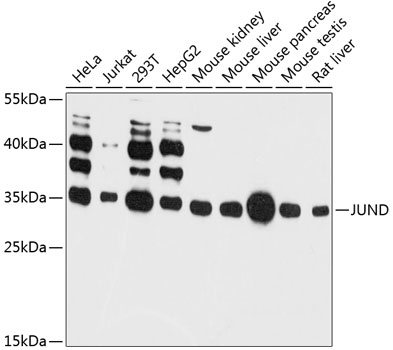Anti-JUND Antibody (CAB11955)
- SKU:
- CAB11955
- Product type:
- Antibody
- Reactivity:
- Human
- Reactivity:
- Mouse
- Reactivity:
- Rat
- Host Species:
- Rabbit
- Isotype:
- IgG
- Antibody Type:
- Polyclonal Antibody
- Research Area:
- Epigenetics and Nuclear Signaling
Description
| 抗体名: | Anti-JUND Antibody |
| 抗体コード: | CAB11955 |
| 抗体サイズ: | 20uL, 50uL, 100uL |
| 申し込み: | WB IHC |
| 反応性: | Human, Mouse, Rat |
| 宿主種: | Rabbit |
| 免疫原: | Recombinant fusion protein containing a sequence corresponding to amino acids 1-190 of human JUND (NP_005345.3). |
| 申し込み: | WB IHC |
| 推奨希釈: | WB 1:500 - 1:2000 IHC 1:50 - 1:100 |
| 反応性: | Human, Mouse, Rat |
| ポジティブサンプル: | HeLa, Jurkat, 293T, HepG2, Mouse kidney, Mouse liver, Mouse pancreas, Mouse testis, Rat liver |
| 免疫原: | Recombinant fusion protein containing a sequence corresponding to amino acids 1-190 of human JUND (NP_005345.3). |
| 精製方法: | Affinity purification |
| ストレージバッファ: | Store at -20'C. Avoid freeze / thaw cycles. Buffer: PBS with 0.02% sodium azide, 50% glycerol, pH7.3. |
| アイソタイプ: | IgG |
| 順序: | METP FYGD EALS GLGG GASG SGGS FASP GRLF PGAP PTAA AGSM MKKD ALTL SLSE QVAA ALKP AAAP PPTP LRAD GAPS AAPP DGLL ASPD LGLL KLAS PELE RLII QSNG LVTT TPTS SQFL YPKV AASE EQEF AEGF VKAL EDLH KQNQ LGAG AAAA AAAA AAGG PSGT ATGS APPG ELAP AAAA PE |
| 遺伝子ID: | 3727 |
| Uniprot: | P17535 |
| セルラーロケーション: | Nucleus |
| 計算された分子量: | 35kDa |
| 観察された分子量: | 35kDa |
| 同義語: | JUND, AP-1 |
| バックグラウンド: | The protein encoded by this intronless gene is a member of the JUN family, and a functional component of the AP1 transcription factor complex. This protein has been proposed to protect cells from p53-dependent senescence and apoptosis. Alternative translation initiation site usage results in the production of different isoforms (PMID:12105216). |
| UniProt Protein Function: | JunD: Transcription factor binding AP-1 sites. Binds DNA as a dimer. Interacts with MEN1; this interaction represses transcriptional activation. Belongs to the bZIP family. Jun subfamily. |
| UniProt Protein Details: | Protein type:Transcription factor; Motility/polarity/chemotaxis Chromosomal Location of Human Ortholog: 19p13.2 Cellular Component: chromatin; nuclear chromatin; nucleus; transcription factor complex Molecular Function:enzyme binding; ligand-dependent nuclear receptor binding; protein binding; transcription coactivator activity; transcription factor binding Biological Process: aging; cellular response to hormone stimulus; circadian rhythm; negative regulation of transcription from RNA polymerase II promoter; osteoblast development; positive regulation of cell differentiation; positive regulation of osteoblast differentiation; positive regulation of transcription from RNA polymerase II promoter; regulation of cell cycle; regulation of cell proliferation; regulation of transcription from RNA polymerase II promoter; response to cAMP; response to cytokine stimulus; response to drug; response to light stimulus; response to lipopolysaccharide; response to mechanical stimulus; response to peptide hormone stimulus; response to radiation; transcription from RNA polymerase II promoter |
| NCBI Summary: | The protein encoded by this intronless gene is a member of the JUN family, and a functional component of the AP1 transcription factor complex. This protein has been proposed to protect cells from p53-dependent senescence and apoptosis. Alternative translation initiation site usage results in the production of different isoforms (PMID:12105216). [provided by RefSeq, Nov 2013] |
| UniProt Code: | P17535 |
| NCBI GenInfo Identifier: | 229462969 |
| NCBI Gene ID: | 3727 |
| NCBI Accession: | P17535.3 |
| UniProt Secondary Accession: | P17535,Q53EK9, |
| UniProt Related Accession: | P17535 |
| Molecular Weight: | 35,174 Da |
| NCBI Full Name: | Transcription factor jun-D |
| NCBI Synonym Full Names: | jun D proto-oncogene |
| NCBI Official Symbol: | JUND |
| NCBI Official Synonym Symbols: | AP-1 |
| NCBI Protein Information: | transcription factor jun-D |
| UniProt Protein Name: | Transcription factor jun-D |
| Protein Family: | Transcription factor |
| UniProt Gene Name: | JUND |
| UniProt Entry Name: | JUND_HUMAN |


